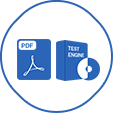Last Update 9 hours ago Total Questions : 141
The Google Cloud Certified - Professional Cloud Database Engineer content is now fully updated, with all current exam questions added 9 hours ago. Deciding to include Professional-Cloud-Database-Engineer practice exam questions in your study plan goes far beyond basic test preparation.
You'll find that our Professional-Cloud-Database-Engineer exam questions frequently feature detailed scenarios and practical problem-solving exercises that directly mirror industry challenges. Engaging with these Professional-Cloud-Database-Engineer sample sets allows you to effectively manage your time and pace yourself, giving you the ability to finish any Google Cloud Certified - Professional Cloud Database Engineer practice test comfortably within the allotted time.
You are configuring a brand new PostgreSQL database instance in Cloud SQL. Your application team wants to have an optimal and highly available environment with automatic failover to avoid any unplanned outage. What should you do?
You are evaluating Cloud SQL for PostgreSQL as a possible destination for your on-premises PostgreSQL instances. Geography is becoming increasingly relevant to customer privacy worldwide. Your solution must support data residency requirements and include a strategy to:
configure where data is stored
control where the encryption keys are stored
govern the access to data
What should you do?
Your company uses Cloud Spanner for a mission-critical inventory management system that is globally available. You recently loaded stock keeping unit (SKU) and product catalog data from a company acquisition and observed hot-spots in the Cloud Spanner database. You want to follow Google-recommended schema design practices to avoid performance degradation. What should you do? (Choose two.)
Your team is building an application that stores and analyzes streaming time series financial data. You need a database solution that can perform time series-based scans with sub-second latency. The solution must scale into the hundreds of terabytes and be able to write up to 10k records per second and read up to 200 MB per second. What should you do?
You host an application in Google Cloud. The application is located in a single region and uses Cloud SQL for transactional data. Most of your users are located in the same time zone and expect the application to be available 7 days a week, from 6 AM to 10PM. You want to ensure regular maintenance updates to your Cloud SQL instance without creating downtime for your users. What should you do?
Your organization stores marketing data such as customer preferences and purchase history on Bigtable. The consumers of this database are predominantly data analysts and operations users. You receive a service ticket from the database operations department citing poor database performance between 9 AM-10 AM every day. Theapplication team has confirmed no latency from their logs. A new cohort of pilot users that is testing a dataset loaded from a third-party data provider is experiencing poor database performance. Other users are not affected. You need to troubleshoot the issue. What should you do?
You are choosing a new database backend for an existing application. The current database is running PostgreSQL on an on-premises VM and is managed by a database administrator and operations team. The application data is relational and has light traffic. You want to minimize costs and the migration effort for this application. What should you do?

